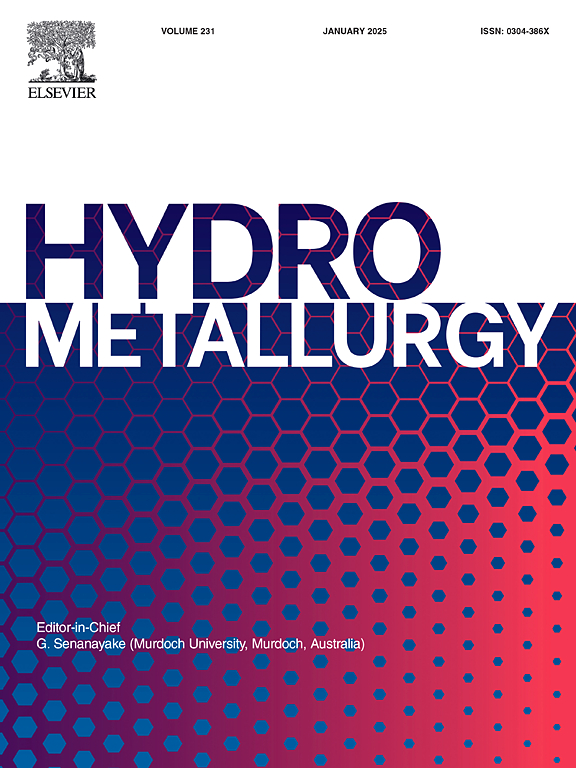Vanadium(II) reductive upgrading of copper sulfide concentrates via Iron leaching to facilitate stagewise oxidative copper leaching at room temperature
IF 4.8
2区 材料科学
Q1 METALLURGY & METALLURGICAL ENGINEERING
引用次数: 0
Abstract
Over this coming decade, copper demand in the United States is projected to increase significantly because of the energy transition to carbon-free sources. Compared to traditional hydrometallurgical processes involving oxidation, reductive leaching of copper mineral concentrates has been shown to yield significant advantages. For example, reductive leaching of chalcopyrite can be performed at ambient temperatures without intensive grinding. This could achieve high yields, reduced processing costs, all while minimizing environmental impacts.
This work explores vanadium reductive leaching of other copper mineral concentrates by measuring leaching kinetics and yields. Over 90 % of the copper was successfully extracted from copper concentrates obtained from three active mines, each with different mineral compositions, after reacting in VSO4, H2SO4 solution at room temperature for 60 min. It was shown that the addition of FeSO4 enhanced the leaching yields of copper from chalcocite (Cu2S), from 55.1 % to 100 % in concentrates having moderate iron concentrations and from 62.7 % to 82.2 % in low-iron concentrates. The copper recovery in low-iron concentrates could be increased to 99 % after leaching a second time, suggesting a staged operation may be favored. Results show that similar yields may be achieved when leaching occurs in a continuous flow reactor with residence times between 10 and 20 min. For example, 85.2 % - 100 % of iron was leached from Source 2 concentrates, and 87.7 % - 95.3 % of iron was leached from Source 3 concentrates in continuous flow leaching. The processing rate using the continuous flow reactor was 87 g/L h−1, a rate competitive with existing processing methods.
铁浸出硫化铜精矿钒(II)还原性提质,促进室温阶段氧化铜浸出
在未来十年,由于能源向无碳能源的转型,美国的铜需求预计将大幅增加。与涉及氧化的传统湿法冶金工艺相比,铜矿物精矿的还原浸出已显示出显着的优势。例如,黄铜矿的还原浸出可以在环境温度下进行,而无需进行密集的研磨。这可以实现高产量,降低加工成本,同时最大限度地减少对环境的影响。本研究通过测量浸出动力学和产率,探讨了其他铜矿物精矿的钒还原浸出。在VSO4、H2SO4溶液中反应60 min后,3个不同矿物组成的活性矿铜精矿的铜提取率均超过90%。结果表明,FeSO4的加入提高了辉铜矿(Cu2S)铜的浸出率,中等铁浓度精矿的铜浸出率从55.1%提高到100%,低铁浓度精矿的铜浸出率从62.7%提高到82.2%。低铁精矿经二次浸出后铜的回收率可提高到99%,建议采用分阶段浸出。结果表明,在连续流反应器中浸出,停留时间在10 ~ 20 min,可获得相似的浸出率。例如,连续流浸出,源2精矿的铁浸出率为85.2% ~ 100%,源3精矿的铁浸出率为87.7% ~ 95.3%。连续流反应器的处理速率为87 g/L h−1,与现有的处理方法相比具有竞争力。
本文章由计算机程序翻译,如有差异,请以英文原文为准。
求助全文
约1分钟内获得全文
求助全文
来源期刊

Hydrometallurgy
工程技术-冶金工程
CiteScore
9.50
自引率
6.40%
发文量
144
审稿时长
3.4 months
期刊介绍:
Hydrometallurgy aims to compile studies on novel processes, process design, chemistry, modelling, control, economics and interfaces between unit operations, and to provide a forum for discussions on case histories and operational difficulties.
Topics covered include: leaching of metal values by chemical reagents or bacterial action at ambient or elevated pressures and temperatures; separation of solids from leach liquors; removal of impurities and recovery of metal values by precipitation, ion exchange, solvent extraction, gaseous reduction, cementation, electro-winning and electro-refining; pre-treatment of ores by roasting or chemical treatments such as halogenation or reduction; recycling of reagents and treatment of effluents.
 求助内容:
求助内容: 应助结果提醒方式:
应助结果提醒方式:


